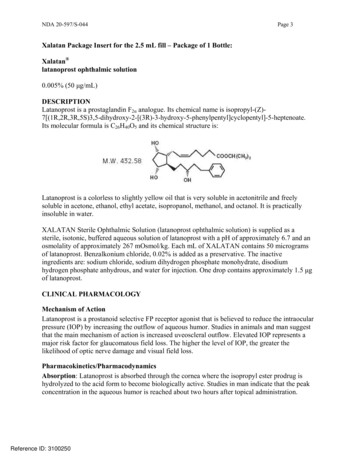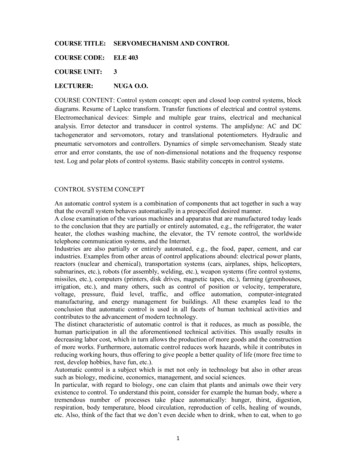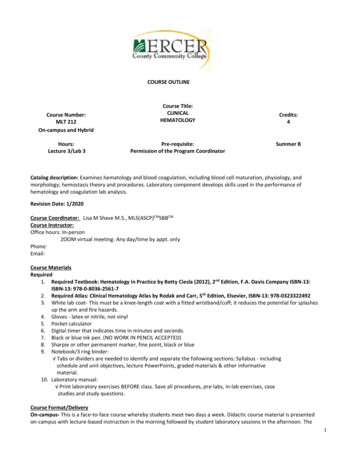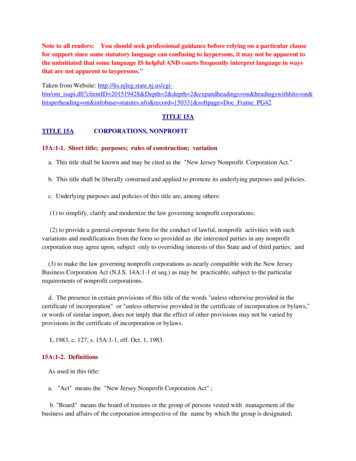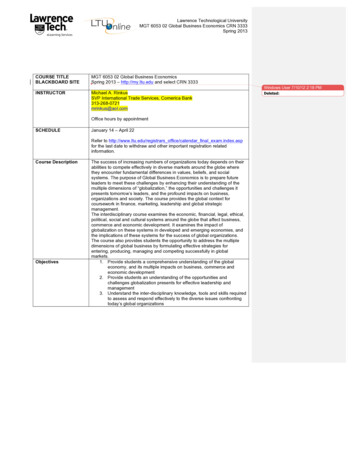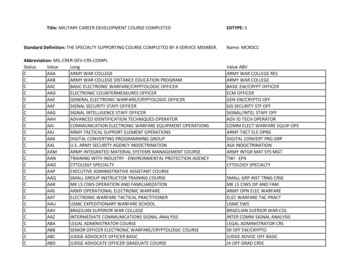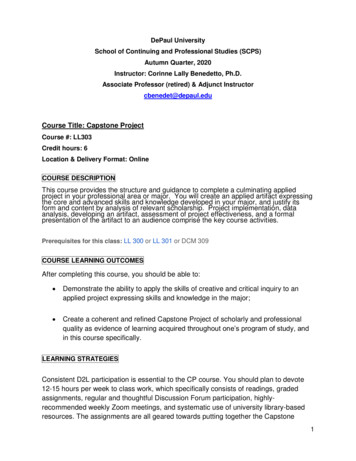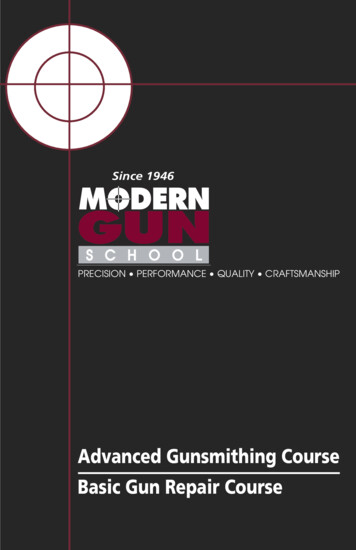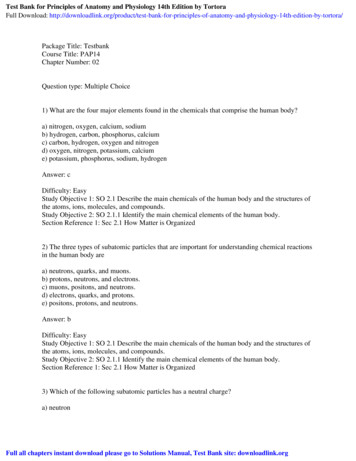
Transcription
Test Bank for Principles of Anatomy and Physiology 14th Edition by TortoraFull Download: ortora/Package Title: TestbankCourse Title: PAP14Chapter Number: 02Question type: Multiple Choice1) What are the four major elements found in the chemicals that comprise the human body?a) nitrogen, oxygen, calcium, sodiumb) hydrogen, carbon, phosphorus, calciumc) carbon, hydrogen, oxygen and nitrogend) oxygen, nitrogen, potassium, calciume) potassium, phosphorus, sodium, hydrogenAnswer: cDifficulty: EasyStudy Objective 1: SO 2.1 Describe the main chemicals of the human body and the structures ofthe atoms, ions, molecules, and compounds.Study Objective 2: SO 2.1.1 Identify the main chemical elements of the human body.Section Reference 1: Sec 2.1 How Matter is Organized2) The three types of subatomic particles that are important for understanding chemical reactionsin the human body area) neutrons, quarks, and muons.b) protons, neutrons, and electrons.c) muons, positons, and neutrons.d) electrons, quarks, and protons.e) positons, protons, and neutrons.Answer: bDifficulty: EasyStudy Objective 1: SO 2.1 Describe the main chemicals of the human body and the structures ofthe atoms, ions, molecules, and compounds.Study Objective 2: SO 2.1.1 Identify the main chemical elements of the human body.Section Reference 1: Sec 2.1 How Matter is Organized3) Which of the following subatomic particles has a neutral charge?a) neutronFull all chapters instant download please go to Solutions Manual, Test Bank site: downloadlink.org
b) electronc) protond) Both neutron and electron.e) All of these choices.Answer: aDifficulty: EasyStudy Objective 1: SO 2.1 Describe the main chemicals of the human body and the structures ofthe atoms, ions, molecules, and compounds.Study Objective 2: SO 2.1.2 Describe the structures of atoms, ions, molecules, free radicals, andcompounds.Section Reference 1: Sec 2.1 How Matter is Organized4) What region of an atom contains the protons and neutrons?a) cloudb) nucleusc) elementd) ringe) shellAnswer: bDifficulty: EasyStudy Objective 1: SO 2.1 Describe the main chemicals of the human body and the structures ofthe atoms, ions, molecules, and compounds.Study Objective 2: SO 2.1.2 Describe the structures of atoms, ions, molecules, free radicals, andcompounds.Section Reference 1: Sec 2.1 How Matter is Organized5) The number of protons in an atom is represented by an element’sa) mass number.b) atomic number.c) atomic mass.d) valence number.e) None of these choices.Answer: bDifficulty: EasyStudy Objective 1: SO 2.1 Describe the main chemicals of the human body and the structures ofthe atoms, ions, molecules, and compounds.
Study Objective 2: SO 2.1.2 Describe the structures of atoms, ions, molecules, free radicals, andcompounds.Section Reference 1: Sec 2.1 How Matter is Organized6) The nucleus of unstable of an element will decay leading to emission of radiation.a) compoundsb) cationsc) anionsd) isotopese) moleculesAnswer: dDifficulty: MediumStudy Objective 1: SO 2.1 Describe the main chemicals of the human body and the structures ofthe atoms, ions, molecules, and compounds.Study Objective 2: SO 2.1.2 Describe the structures of atoms, ions, molecules, free radicals, andcompounds.Section Reference 1: Sec 2.1 How Matter is Organized7) This refers to a weighted average of the atomic weights of all naturally occurring isotopes ofan element.a) mass numberb) atomic numberc) atomic massd) ionic masse) covalent massAnswer: cDifficulty: MediumStudy Objective 1: SO 2.1 Describe the main chemicals of the human body and the structures ofthe atoms, ions, molecules, and compounds.Study Objective 2: SO 2.1.2 Describe the structures of atoms, ions, molecules, free radicals, andcompounds.Section Reference 1: Sec 2.1 How Matter is OrganizedQuestion type: Essay
8) Briefly describe the octet rule.Answer:Difficulty: MediumStudy Objective 1: SO 2.2 Explain how atoms form molecules and compounds, and describe thenature of the various types of bonds that join them.Study Objective 2: SO 2.2.1 Describe how valence electrons form chemical bonds.Study Objective 3: SO 2.2.2 Distinguish among ionic, covalent, and hydrogen bonds.Section Reference 1: Sec 2.2 Chemical BondsSolution: One atom is more likely to combine with another atom if doing so will leave bothatoms with eight electrons in their valence shells.Question type: Multiple Choice9) Which of the following subatomic particles are shared by two atoms to form covalent bonds?1. neutron2. electron3. protona) 1 onlyb) 2 onlyc) 3 onlyd) 2 & 3 onlye) 1, 2 & 3Answer: bDifficulty: MediumStudy Objective 1: SO 2.2 Explain how atoms form molecules and compounds, and describe thenature of the various types of bonds that join them.Study Objective 2: SO 2.2.1 Describe how valence electrons form chemical bonds.Study Objective 3: SO 2.2.2 Distinguish among ionic, covalent, and hydrogen bonds.Section Reference 1: Sec 2.2 Chemical Bonds10) What is the name given to a negatively charged atom?a) superoxideb) isotopec) catalystd) anione) cation
Answer: dDifficulty: EasyStudy Objective 1: SO 2.2 Explain how atoms form molecules and compounds, and describe thenature of the various types of bonds that join them.Study Objective 2: SO 2.2.1 Describe how valence electrons form chemical bonds.Section Reference 1: Sec 2.2 Chemical Bonds11) A chemical that can conduct electrical current when dissolved in water is called a(n)a) isotope.b) isomer.c) compound.d) electrolytee) valence molecule.Answer: dDifficulty: EasyStudy Objective 1: SO 2.2 Explain how atoms form molecules and compounds, and describe thenature of the various types of bonds that join them.Study Objective 2: SO 2.2.1 Describe how valence electrons form chemical bonds.Section Reference 1: Sec 2.2 Chemical Bonds12) Which type of chemical bond involves the sharing of valence electrons between two atoms?a) covalentb) ionicc) hydrogend) atomice) electronicAnswer: aDifficulty: EasyStudy Objective 1: SO 2.2 Explain how atoms form molecules and compounds, and describe thenature of the various types of bonds that join them.Study Objective 2: SO 2.2.1 Describe how valence electrons form chemical bonds.Study Objective 3: SO 2.2.2 Distinguish among ionic, covalent, and hydrogen bonds.Section Reference 1: Sec 2.2 Chemical Bonds13) The chemical bonds formed between the atoms in a water molecule are called
a) nonpolar covalent bonds.b) polar covalent bonds.c) hydrogen bonds.d) ionic bonds.e) atomic bonds.Answer: bDifficulty: MediumStudy Objective 1: SO 2.2 Explain how atoms form molecules and compounds, and describe thenature of the various types of bonds that join them.Study Objective 2: SO 2.2.1 Describe how valence electrons form chemical bonds.Study Objective 3: SO 2.2.2 Distinguish among ionic, covalent, and hydrogen bonds.Section Reference 1: Sec 2.2 Chemical BondsQuestion type: Essay14) Describe a hydrogen bond.Answer:Difficulty: MediumStudy Objective 1: SO 2.2 Explain how atoms form molecules and compounds, and describe thenature of the various types of bonds that join them.Study Objective 2: SO 2.2.1 Describe how valence electrons form chemical bonds.Study Objective 3: SO 2.2.2 Distinguish among ionic, covalent, and hydrogen bonds.Section Reference 1: Sec 2.2 Chemical BondsSolution: Hydrogen bonds form between a hydrogen atom that has partial positive charge andanother atom, like oxygen or nitrogen, carrying partial negative charge.Question type: Multiple Choice15) Which relatively weak type of bond helps stabilize the three dimensional structure of largemolecules like proteins and DNA?a) nonpolar covalentb) polar covalentc) hydrogend) ionice) atomicAnswer: c
Difficulty: MediumStudy Objective 1: SO 2.2 Explain how atoms form molecules and compounds, and describe thenature of the various types of bonds that join them.Study Objective 2: SO 2.2.1 Describe how valence electrons form chemical bonds.Study Objective 3: SO 2.2.2 Distinguish among ionic, covalent, and hydrogen bonds.Section Reference 1: Sec 2.2 Chemical Bonds16) A chemical reaction involves interactions between the of two different atoms.a) neutronsb) protonsc) isotopesd) valence electronse) ionsAnswer: dDifficulty: EasyStudy Objective 1: SO 2.2 Explain how atoms form molecules and compounds, and describe thenature of the various types of bonds that join them.Study Objective 2: SO 2.2.1 Describe how valence electrons form chemical bonds.Study Objective 3: SO 2.2.2 Distinguish among ionic, covalent, and hydrogen bonds.Section Reference 1: Sec 2.2 Chemical Bonds17) Which term is defined as the capacity to do work?a) metabolismb) electrolytesc) chemical reactiond) concentratione) energyAnswer: eDifficulty: MediumStudy Objective 1: SO 2.3 Explain what happens when atoms combine with or separate fromother atoms during a chemical reaction.Study Objective 2: SO 2.3.1 Define a chemical reaction.Study Objective 3: SO 2.3.2 Describe the various forms of energy.Section Reference 1: Sec 2.3 Chemical ReactionsQuestion type: Essay
18) Describe the law of conservation of energy.Answer:Difficulty: MediumStudy Objective 1: SO 2.3 Explain what happens when atoms combine with or separate fromother atoms during a chemical reaction.Study Objective 2: SO 2.3.1 Define a chemical reaction.Study Objective 3: SO 2.3.2 Describe the various forms of energy.Section Reference 21: 2.3 Chemical ReactionsSolution: Energy cannot be created or destroyed but it may be converted from one form toanother form.Question type: Multiple Choice19) Which type of chemical reaction will absorb more energy than it releases?a) exergonicb) endergonicc) potentiald) kinetice) activationAnswer: bDifficulty: EasyStudy Objective 1: SO 2.3 Explain what happens when atoms combine with or separate fromother atoms during a chemical reaction.Study Objective 2: SO 2.3.1 Define a chemical reaction.Study Objective 3: SO 2.3.2 Describe the various forms of energy.Section Reference 1: Sec 2.3 Chemical Reactions20) An enzyme acts toa) raise the activation energy needed to start the reaction.b) lower the activation energy needed to start the reaction.c) convert the activation energy into potential energy.d) convert the activation energy into kinetic energy.e) stop a chemical reaction.Answer: b
Difficulty: MediumStudy Objective 1: SO 2.3 Explain what happens when atoms combine with or separate fromother atoms during a chemical reaction.Study Objective 2: SO 2.3.1 Define a chemical reaction.Study Objective 3: SO 2.3.2 Describe the various forms of energy.Study Objective 4: SO 2.3.4 Describe the role of activation energy and catalysts in chemicalreactions.Section Reference 1: Sec 2.3 Chemical ReactionsQuestion type: Essay21) List three factors that increase the rate of chemical reactions.Answer:Difficulty: HardStudy Objective 1: SO 2.3 Explain what happens when atoms combine with or separate fromother atoms during a chemical reaction.Study Objective 2: SO 2.3.1 Define a chemical reaction.Study Objective 3: SO 2.3.2 Describe the various forms of energy.Study Objective 4: SO 2.3.4 Describe the role of activation energy and catalysts in chemicalreactions.Section Reference 1: Sec 2.3 Chemical ReactionsSolution: Three factors that increase reaction rates are the presence of enzymes (catalysts),increased concentration of reactants, and increased temperature.Question type: Multiple Choice22) Which type of chemical reaction combines reactants to produce larger products?a) synthesisb) decompositionc) potentiald) exchangee) activatedAnswer: aDifficulty: MediumStudy Objective 1: SO 2.3 Explain what happens when atoms combine with or separate fromother atoms during a chemical reaction.
Study Objective 2: SO 2.3.1 Define a chemical reaction.Study Objective 3: SO 2.3.5 Describe synthesis, decomposition, exchange, and reversiblereactions.Section Reference 1: Sec 2.3 Chemical Reactions23) Which type of chemical reaction breaks larger reactants into smaller products?a) synthesisb) decompositionc) potentiald) exchangee) activatedAnswer: bDifficulty: MediumStudy Objective 1: SO 2.3 Explain what happens when atoms combine with or separate fromother atoms during a chemical reaction.Study Objective 2: SO 2.3.1 Define a chemical reaction.Study Objective 3: SO 2.3.5 Describe synthesis, decomposition, exchange, and reversiblereactions.Section Reference 1: Sec 2.3 Chemical Reactions24) What is the most abundant and most important inorganic compound in the body?a) waterb) oxygen gasc) carbon dioxided) glucosee) DNAAnswer: aDifficulty: EasyStudy Objective 1: SO 2.4 Explain the importance of water, salts, acids, and bases in thefunctioning of the human body.Study Objective 2: SO 2.4.1 Describe the properties of water and those of inorganic acids, bases,and salts.Section Reference 1: Sec 2.4 Inorganic Compounds and Solutions25) A solute that readily dissolves in water isa) hydrophobic.
b) hydrostatic.c) lipophilic.d) hydrophilic.e) hydrozone.Answer: dDifficulty: EasyStudy Objective 1: SO 2.4 Explain the importance of water, salts, acids, and bases in thefunctioning of the human body.Study Objective 2: SO 2.4.1 Describe the properties of water and those of inorganic acids, bases,and salts.Section Reference 1: Sec 2.4 Inorganic Compounds and Solutions26) In the body fluid compartments found in the human body, the solvent isa) glucose.b) lipids.c) carbon dioxide.d) water.e) electrolyte.Answer: dDifficulty: EasyStudy Objective 1: SO 2.4 Explain the importance of water, salts, acids, and bases in thefunctioning of the human body.Study Objective 2: SO 2.4.1 Describe the properties of water and those of inorganic acids, bases,and salts.Section Reference 1: Sec 2.4 Inorganic Compounds and SolutionsQuestion type: Essay27) Describe the functions of water in the body.Answer:Difficulty: HardStudy Objective 1: SO 2.4 Explain the importance of water, salts, acids, and bases in thefunction
Package Title: Testbank Course Title: PAP14 Chapter Number: 02 Question type: Multiple Choice 1) What are the four major elements found in the chemicals that comprise the human body?

